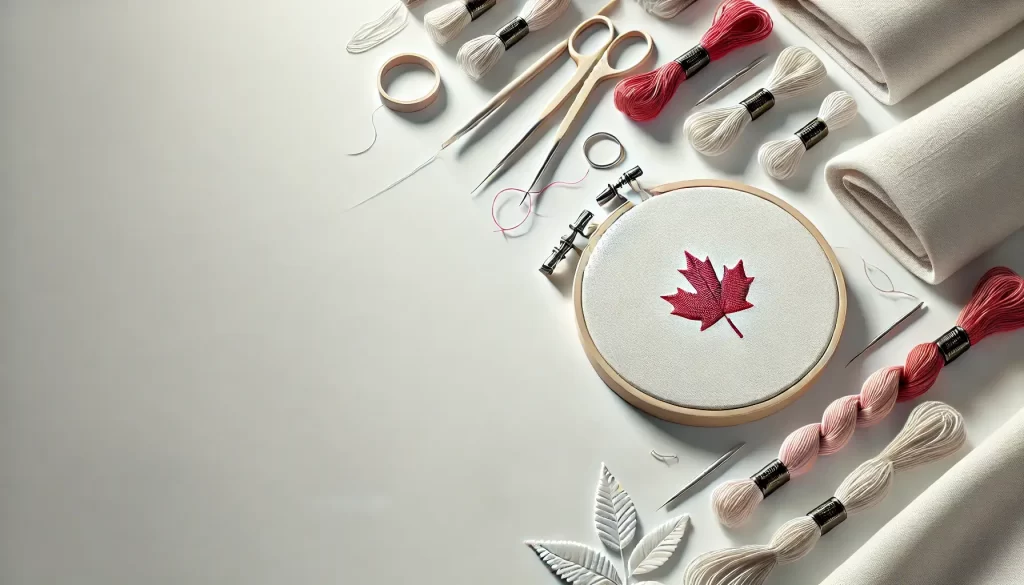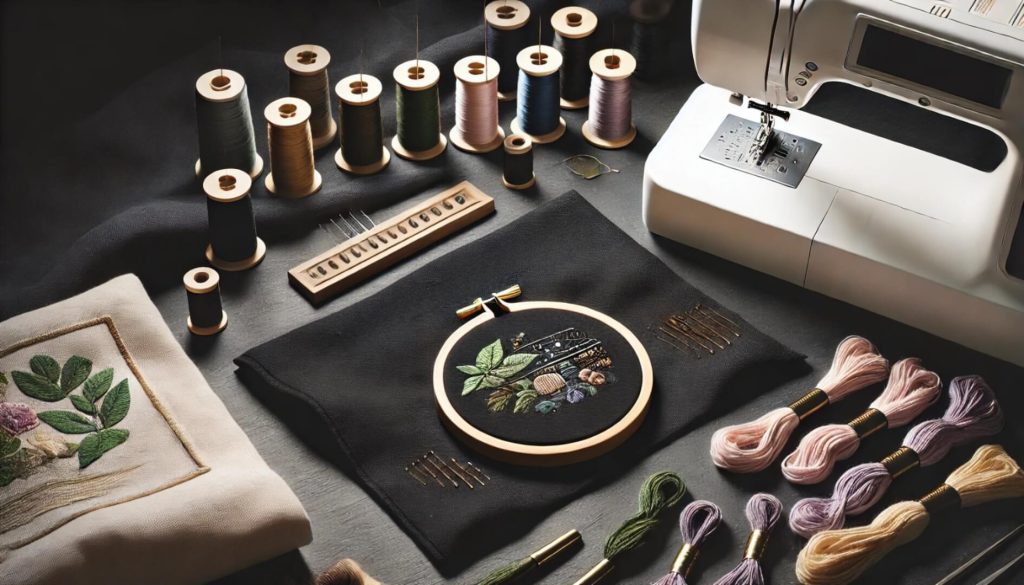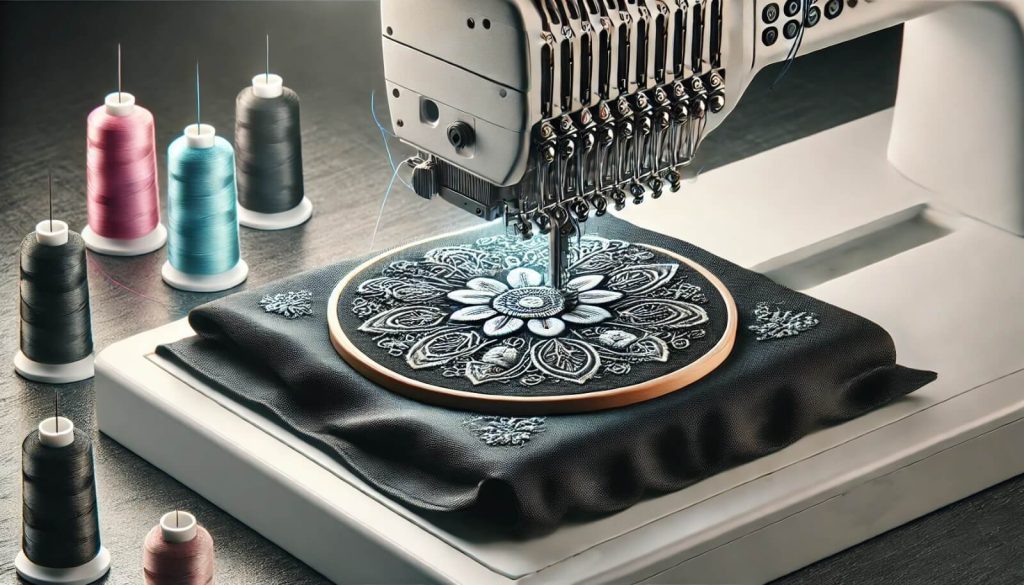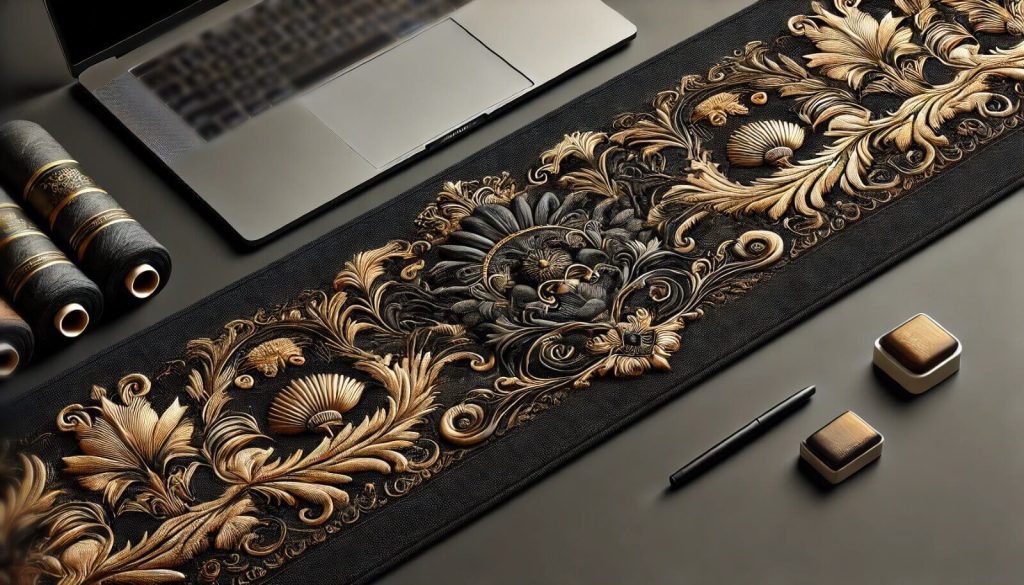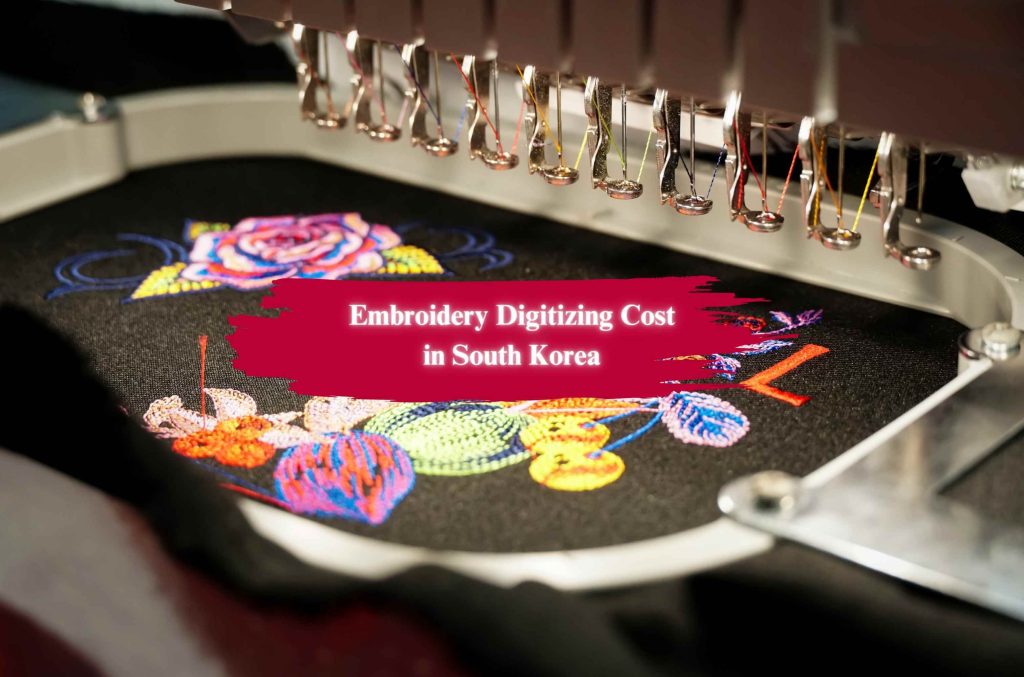Embroidery, a timeless craft, has continually evolved with advancements in technology. One of the most innovative techniques to emerge is appliqué digitizing—a method that combines traditional appliqué with digital precision. This approach enhances embroidery by adding depth, texture, and visual appeal, all while saving time and costs.
In this comprehensive guide, we’ll explore everything you need to know about appliqué digitizing. We’ll discuss its history, the tools you’ll need, step-by-step instructions, its benefits, and much more. By the end of this blog, you’ll understand why appliqué digitizing has become a cornerstone for hobbyists and professionals alike.
Embroidery Digitizing & Applique Digitizing
What is Embroidery Digitizing? In short, embroidery digitizing is a technique transforming fabric into art. From ancient hand-sewn patterns to modern machine embroidery, the craft has adapted to meet creative and practical demands. Appliqué digitizing, a contemporary technique, has revolutionized embroidery by simplifying the process and expanding creative possibilities.
What is Applique Digitizing? It’s the process of converting designs into digital embroidery files, which machines use to stitch layers of fabric onto a base. This technique is not just about aesthetics—it’s also a cost-effective and efficient way to create stunning designs with minimal effort.
This blog will delve into the art and science of appliqué digitizing, offering a complete guide for beginners and experts. We’ll also touch on the broader field of embroidery digitizing and explore its categories.
Understanding Appliqué and Its History
Appliqué is a sewing technique where pieces of fabric are stitched onto a base material to create patterns or designs. The word “appliqué” is derived from the French term meaning “to apply,” which perfectly describes its process.
The Historical Roots of Appliqué
- Ancient Origins: Appliqué traces back to ancient Egypt and Asia, where fabric scraps were repurposed for decorative purposes.
- Cultural Significance: In African textiles, appliqué often served as a storytelling medium. In Europe, it was a staple in creating elaborate tapestries and quilts.
- Modern Transition: The Industrial Revolution brought sewing machines, making appliqué faster and more precise. This evolution set the stage for digitized appliqué.
What Is Appliqué Digitizing?
Appliqué digitizing is the modern adaptation of this ancient craft. It involves creating a digital embroidery file that guides a machine to stitch fabric pieces onto a base material.
How Does Appliqué Digitizing Work?
- Design Selection: Choose or create a design that is compatible with appliqué, such as bold shapes or intricate patterns.
- Digitizing Artwork: Use embroidery software to convert the design into a machine-readable format (e.g., DST or PES).
- Fabric Placement: The machine stitches a placement line, showing where the fabric piece should be positioned.
- Tacking Stitches: A tack-down stitch secures the fabric to the base material.
- Finishing Stitches: Satin or zigzag stitches cover the raw edges for a polished look.
Benefits of Appliqué Digitizing
- Adds texture and dimension.
- Reduces stitch count, saving time and thread.
- Offers endless customization options with various fabrics.
Tools and Materials Needed for Appliqué Digitizing
Getting started with appliqué digitizing requires a combination of technical tools and high-quality materials. The right equipment ensures that your designs are precise, professional, and long-lasting. Here’s a detailed breakdown of what you need:
Tools for Appliqué Digitizing
- Embroidery Software
Embroidery software is the backbone of the digitizing process. It helps convert designs into machine-readable files and allows customization of stitch types, placement lines, and finishing touches.- Popular Options:
- Hatch Embroidery Software: Known for its user-friendly interface and advanced features.
- Brother PE-Design: Ideal for beginners and professionals alike.
- Wilcom Embroidery Studio: Offers industry-standard tools for complex designs.
- Features to Look For:
- Appliqué-specific tools.
- File compatibility (e.g., DST, PES).
- Pre-set stitching templates for beginners.
- Popular Options:
- Embroidery Machines
Not all machines can handle appliqué designs, so choosing one with the right features is essential. Look for:- Precision Stitching: Ensures accuracy, especially for intricate designs.
- File Compatibility: This should support the file formats created by your software.
- Trusted Brands: Brother, Janome, and Bernina are reliable choices with advanced features.
Materials for Appliqué Digitizing
- Fabric
Selecting the right fabric is crucial for achieving the desired texture and contrast.- Use sturdy fabrics that won’t fray easily, such as felt, cotton, or polyester blends.
- Choose contrasting fabrics to make designs pop or subtle tones for a layered look.
- Stabilizers
Stabilizers are essential for keeping fabric in place during stitching.- Types of Stabilizers:
- Tear-Away Stabilizers: Ideal for lightweight fabrics.
- Cut-Away Stabilizers: Best for dense or heavy designs.
- Adhesive Stabilizers: For delicate fabrics that require minimal handling.
- Types of Stabilizers:
- Threads
High-quality threads enhance durability and ensure your design stands out.- Polyester Threads: Known for strength and resistance to wear.
- Rayon Threads: Provide a shiny finish, perfect for decorative designs.
- Adhesives
Heat-activated adhesives or spray adhesives can hold fabric pieces in place temporarily before stitching. This ensures precise placement. - Cutting Tools
- Embroidery Scissors: For trimming excess fabric.
- Rotary Cutters: For cutting large fabric pieces with precision.
Step-by-Step Guide: How to Do Appliqué Digitizing
1st Step: Select a Design
- Start by choosing a design compatible with appliqué. For beginners, simple shapes like circles or hearts are ideal, while experienced digitizers can experiment with complex patterns like floral designs or logos.
- Consider the fabric’s role in the design. Will it add texture, contrast, or both?
2nd Step: Digitize the Design
- Upload Artwork: Import your chosen design into embroidery software.
- Add a Placement Line: This guides where the fabric will be placed.
- Tack-Down Stitches: Secure the fabric to the base material.
- Finishing Stitches: Apply satin or zigzag stitches to cover raw edges. Use software presets for consistent results.
3rd Step: Prepare Materials
- Cut the appliqué fabric slightly larger than the placement line.
- Select a thread color that complements or contrasts with the fabric.
- Prepare the stabilizer and attach it to the base material.
4th Step: Stitch the Placement Line
- Load the design into the embroidery machine and stitch the placement line onto the base fabric.
5th Step: Place the Fabric
- Align the appliqué fabric with the placement line. Ensure there are no wrinkles or misalignments.
6th Step: Add Tack-Down Stitches
- The machine stitches the fabric in place, securing it to the base material.
7th Step: Apply Finishing Stitches
- Use satin or zigzag stitches to cover the edges of the appliqué fabric. This creates a polished, professional look.
8th Step: Trim Excess Fabric
- Carefully trim any fabric outside the stitched edges using embroidery scissors. Precision is key to avoid damaging the stitches.
The Advantages of Appliqué Digitizing
Key Benefits of Appliqué Digitizing
- Time Efficiency
- Reduces the number of stitches, allowing for quicker production.
- Ideal for large designs where dense stitching would be time-consuming.
- Cost Savings
- Minimizes thread usage by replacing dense stitching with fabric.
- Economical for high-volume production.
- Creative Versatility
- Enables the mixing of textures, fabrics, and colors for unique results.
- Opens up endless possibilities for customization.
- Enhanced Durability
- Fabric layers withstand wear better than dense stitching.
- Suitable for frequently used items like apparel and accessories.
Practical Applications of Appliqué Digitizing
Appliqué digitizing is a highly versatile technique with applications across a wide range of projects. By combining fabric and embroidery, it provides endless opportunities for personalization, branding, and artistic expression. Here are some expanded practical applications of appliqué digitizing:
Apparel
Appliqué digitizing is widely used in the fashion and clothing industry to add unique, eye-catching details to garments.
- T-Shirts: Personalize casual wear with bold, colorful appliqué designs. Monograms, quirky patterns, or themed graphics can turn simple T-shirts into statement pieces.
- Jackets: Add intricate designs to the back or sleeves of denim or bomber jackets. Patches and appliqué logos are especially popular for sports and college apparel.
- Children’s Clothing: Create playful, whimsical designs for kids’ outfits. Use soft fabrics to ensure comfort while adding colorful patterns like animals, flowers, or cartoon characters.
Home Décor
Appliqué digitizing can transform everyday household items into decorative masterpieces.
- Pillows: Add monograms, floral patterns, or seasonal motifs to cushions and throw pillows.
- Quilts: Incorporate appliqué to create intricate patterns and themes, making each quilt a personalized heirloom.
- Curtains and Table Linens: Enhance these items with appliqué borders or focal designs that match the room’s décor.
Accessories
Accessories provide a smaller canvas, but appliqué digitizing makes them just as impactful.
- Bags: Add patches, logos, or vibrant appliqué designs to tote bags, backpacks, or handbags for a personalized touch.
- Hats: Use appliqué digitizing to add raised designs, initials, or logos to caps and beanies, making them fashionable and functional.
- Scarves: Create elegant or playful designs along the edges or corners of scarves, blending embroidery with soft fabrics.
Corporate Branding
Businesses increasingly use appliqué digitizing for branding purposes, thanks to its cost-effectiveness and high visual appeal.
- Uniforms: Add company logos or team names to uniforms, jackets, or hats.
- Promotional Merchandise: Create branded patches for giveaways, such as on backpacks, T-shirts, or hoodies.
- Team and Club Apparel: Appliqué designs are perfect for sports teams, hobby groups, or corporate clubs, offering a professional yet personal look.
By integrating appliqué digitizing into these applications, designers and businesses can produce customized, high-quality results that resonate with their audience.
Future Trends in Appliqué Digitizing
Appliqué digitizing is evolving, with emerging trends and innovations shaping its future. These developments make the technique more sustainable, efficient, and adaptable to diverse creative needs.
Eco-Friendly Practices
Sustainability is becoming a key focus in the embroidery industry, and appliqué digitizing plays a significant role in promoting eco-friendly practices.
- Upcycling Fabric Scraps: Many digitizers and designers are repurposing leftover fabrics from other projects to create appliqué designs, reducing waste.
- Sustainable Materials: Eco-friendly stabilizers, threads, and adhesives are being developed to minimize the environmental impact.
- Green Manufacturing: Businesses offering appliqué digitizing services are moving toward renewable energy sources and ethical production methods.
AI Integration
Artificial intelligence (AI) is revolutionizing appliqué digitizing by automating complex tasks, increasing accuracy, and reducing the time required to complete projects.
- Design Automation: AI-powered embroidery software can generate placement lines, tack-down stitches, and finishing stitches automatically, streamlining the digitizing process.
- Error Detection: Advanced tools can identify potential issues, such as misaligned stitches or incompatible fabrics before production begins.
- Custom Recommendations: AI tools suggest color palettes, stitch types, and fabric options based on design trends and user preferences.
Increased Personalization
The growing demand for personalized products is driving innovation in appliqué digitizing.
- Custom Designs: Consumers increasingly seek unique, one-of-a-kind items for personal use or gifting. Appliqué digitizing caters to this demand by enabling fully customized designs.
- Niche Markets: Businesses are using appliqué digitizing to target niche markets, such as themed apparel, wedding décor, or cultural textiles.
- On-Demand Production: With advancements in digitizing and embroidery machines, businesses can produce small batches or single items quickly and affordably.
Expanding Software Capabilities
As software evolves, appliqué digitizing is becoming more accessible and sophisticated.
- Cloud-Based Solutions: Online tools allow digitizers to work from anywhere, collaborating with clients and team members in real time.
- Mobile Apps: Developers are creating apps for smartphones and tablets, making it easier for beginners to experiment with designs.
Top Related Categories of Embroidery Digitizing
Embroidery digitizing services are versatile with many specialized categories:
- Custom Embroidery Digitizing Services
- Tailored designs for specific projects or personal requests.
- Perfect for unique patterns or one-of-a-kind items.
- Logo Digitizing Services
- Converts logos into stitchable designs.
- Essential for branding apparel, caps, and corporate gifts.
- 3D Puff Embroidery Digitizing Service
- Adds a raised effect to designs for a three-dimensional look.
- Popular for caps and sportswear.
- Monogram Digitizing Service
- Ideal for personalizing towels, robes, and other textiles with initials or names.
- Patch Digitizing Service
- Creates patches for uniforms, clubs, or events.
- Durable and easy to attach to garments.
- Photo-to-Embroidery Digitizing Service
- Converts photographs into intricate embroidery designs.
- Often used for portraits or commemorative items.
- Small Lettering Digitizing Service
- Focuses on making small text readable and precise.
- Font/Lettering Digitizing Service
- Customizes fonts for unique or branded designs.
- Color blending digitizing service
- Gradually transitions between colors for a gradient effect.
Conclusion
Appliqué digitizing is not just a technique—it’s a creative revolution that merges tradition with modern technology. Whether you’re embellishing apparel, enhancing home décor, or creating corporate branding materials, appliqué digitizing offers limitless possibilities. Its combination of efficiency, versatility, and sustainability makes it a must-have skill for both hobbyists and professionals.
As the technique continues to evolve with trends like eco-friendly practices and AI integration, the future of appliqué digitizing looks brighter than ever. By mastering this skill, you can produce stunning, personalized designs that stand out in a competitive market.
So, why wait? Start experimenting with appliqué digitizing services today and transform your creative ideas into tangible masterpieces!
FAQs About Appliqué Digitizing
What is appliqué digitizing pricing like?
Appliqué digitizing pricing depends on several factors, including the complexity of the design, the size of the project, and the service provider.
- Basic Designs: Start at $10–$15 for simple shapes or monograms.
- Intricate Patterns: Can range from $50 to $100 or more for highly detailed or large designs.
- Bulk orders or recurring projects often qualify for discounts from service providers.
Are there appliqué digitizing services in Arizona, California, and Texas?
Yes, appliqué digitizing services are widely available in these states.
- Arizona: Known for boutique embroidery businesses offering custom digitizing.
- California: Features many professional services catering to fashion brands and corporate clients.
- Texas: A hub for promotional and sports embroidery, with many appliqué digitizing experts.
Among these, Quality Designx is a trusted provider known for its precision and quality.
How can I find the best appliqué digitizing service?
To find a reliable service provider:
- Check Appliqué Digitizing Portfolios: Look for a variety of projects that demonstrate their expertise.
- Read Reviews: Positive feedback from previous clients indicates consistent quality.
- Consider Experience: Established providers like Quality Designx are highly recommended for their attention to detail.
What fabrics are best for appliqué digitizing?
Selecting the right fabric ensures the success of your appliqué project.
- Cotton: Durable and easy to work with, making it a top choice for beginners.
- Felt: Sturdy and doesn’t fray, ideal for clean edges.
- Polyester Blends: Provide flexibility and durability for complex designs.
Avoid stretchy or overly thin fabrics unless stabilized appropriately.
Can I digitize my own designs?
Absolutely! With the right software and practice, you can digitize your designs for personal or professional use.
- Beginners should start with simple shapes and gradually move to intricate designs.
- Many online tutorials and forums guide those new to appliqué digitizing.
What’s the difference between appliqué digitizing and traditional embroidery digitizing?
- Appliqué Digitizing: Focuses on layering fabric pieces onto a base material, reducing stitch density.
- Traditional Embroidery Digitizing: Uses thread to fill all areas of the design.
Appliqué is more efficient for large designs and provides added texture and dimension.
What software is best for appliqué digitizing?
- Hatch Embroidery Software: User-friendly with powerful appliqué features.
- Wilcom Studio: A professional-grade option for complex designs.
- Brother PE-Design: Ideal for hobbyists and small businesses.
Free or budget-friendly options like Ink/Stitch are also available for beginners.
What stabilizers should I use for appliqué digitizing?
Stabilizers depend on the fabric and design:
- Tear-Away Stabilizers: Great for lightweight or non-stretch fabrics.
- Cut-Away Stabilizers: Suitable for heavy or dense designs.
- Adhesive Stabilizers: Prevent shifting when working with delicate fabrics.
Can I use multiple fabrics in one design?
Yes! Mixing fabrics adds texture and complexity to your appliqué design.
- For example, combine felt for structure, satin for shine, and cotton for patterns.
- Test fabric combinations to ensure they complement each other visually and functionally.
What are common mistakes in appliqué digitizing?
- Misaligned Placement: Avoid this by double-checking your placement line.
- Improper Trimming: Use sharp scissors to prevent rough edges.
- Skipping Stabilizers: Always stabilize your fabric to avoid puckering or distortion.
- Rushing the Process: Test your design on scrap fabric to identify and fix issues.
What makes appliqué digitizing better for large designs?
- Reduced Stitch Count: Fabric fills large areas instead of dense stitches, speeding up production.
- Cost-Effective: Saves on the thread and reduces machine wear.
- Enhanced Aesthetic: Layered fabrics provide dimension and vibrancy not achievable with thread alone.
How do I clean and maintain appliqué embroidery?
- Wash gently in cold water and avoid harsh detergents.
- Air dry or use low heat settings to protect the appliqué and stitches.
- Iron on the reverse side or use a pressing cloth to prevent damage.
Can appliqué digitizing be used for patches?
Yes, appliqué digitizing is an excellent choice for creating durable, visually striking patches.
- It’s cost-effective for large designs.
- Satin stitches around the edges make the patch easy to sew or iron onto garments.
What industries benefit most from appliqué digitizing?
- Fashion and Apparel: Adds texture and uniqueness to garments.
- Home Décor: Used for pillows, curtains, and quilts.
- Sports Teams: Creates bold logos and lettering for uniforms.
- Corporate Branding: Ideal for promotional items like hats, jackets, and bags.
How long does it take to complete an appliqué digitizing project?
The time required depends on:
- The complexity of the design.
- The size of the appliqué area.
- Experience level and tools available.
On average, small projects can be completed within a few hours, while intricate designs may take a day or more.
Can I use appliqué digitizing on stretchy fabrics?
Yes, but extra care is needed.
- Use cut-away stabilizers to provide support.
- Choose fabrics that stretch minimally or use adhesives to reduce movement during stitching.
What is the best way to learn appliqué digitizing?
- Practice with simple designs and progress to complex patterns.
- Watch video tutorials from experts.
- Join online communities or forums to share tips and troubleshoot issues.
- Experiment with different tools, fabrics, and techniques to develop your skills.



